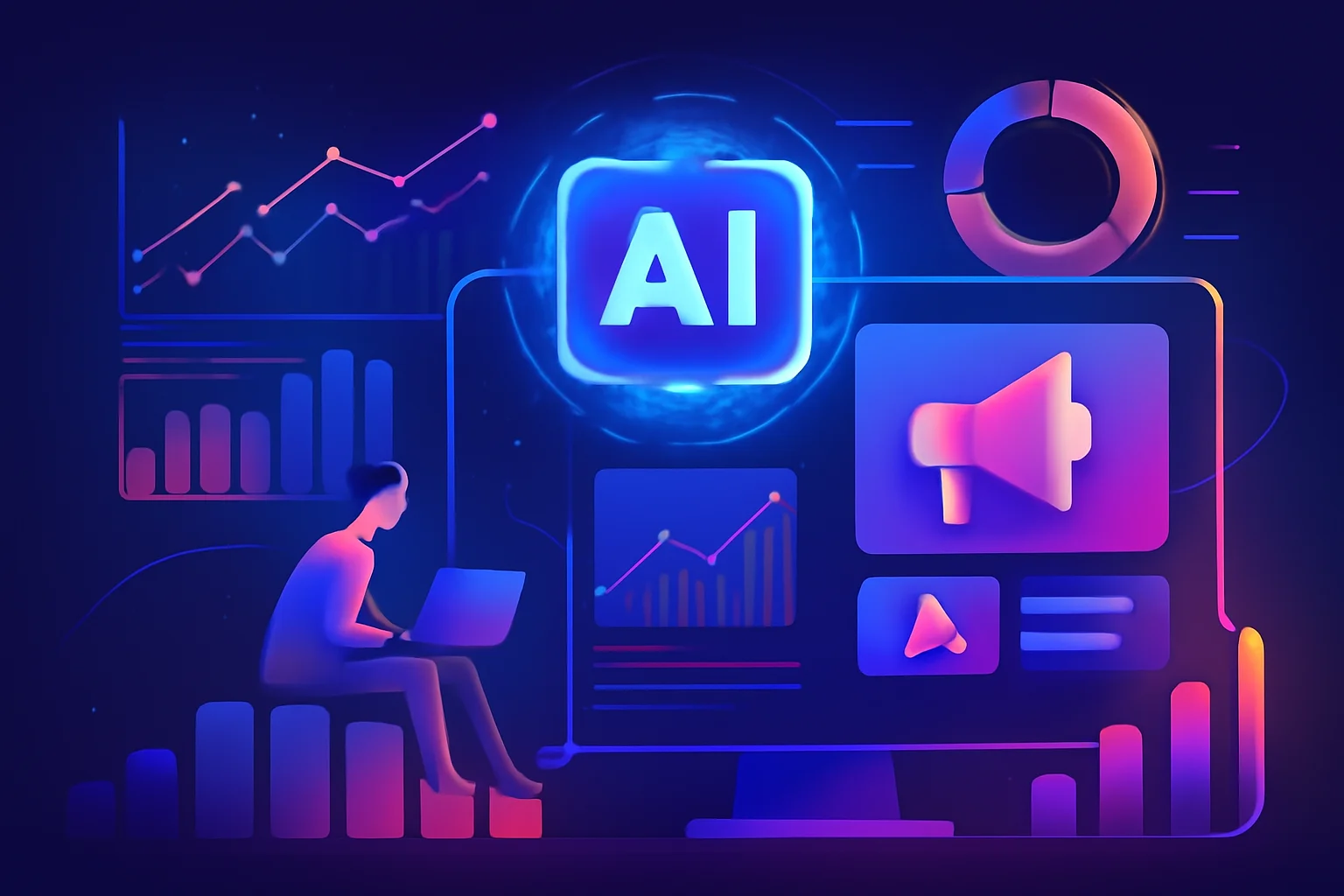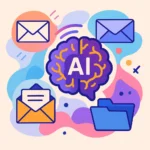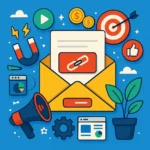Now Reading: AI in Digital Advertising Optimization: From Wasted Spend to Wins
-
01
AI in Digital Advertising Optimization: From Wasted Spend to Wins
AI in Digital Advertising Optimization: From Wasted Spend to Wins

Are your digital advertising campaigns delivering the results you need, or are you watching your budget disappear with disappointing returns? If you’re like most marketers I’ve worked with, you’re probably somewhere in the middle-seeing some success but knowing there’s untapped potential. That’s where AI in digital advertising optimization enters the picture, transforming how brands connect with audiences and dramatically improving campaign performance. I’ve spent years helping businesses implement these technologies, and I’m excited to share exactly how you can use AI to revolutionize your advertising approach.
Key Takeaways
How to Use AI to Optimize Digital Advertising Campaigns:
- Implement Smart Bidding with broad match keywords to automate bid adjustments and target relevant searches beyond exact matches
- Leverage predictive analytics to forecast campaign performance and identify high-value audience segments
- Use AI for dynamic content creation that personalizes ad messaging at scale for different audience segments
- Automate A/B testing of ad variations to continuously improve creative performance
- Employ sentiment analysis to understand audience reactions and refine messaging accordingly
- Utilize real-time optimization to adjust campaigns based on performance metrics as they happen
AI-Powered Bidding Strategies
When I first started using AI in my digital advertising campaigns, Smart Bidding was my entry point-and it remains one of the most accessible ways to leverage artificial intelligence for campaign optimization. Google’s AI-powered bidding strategies have completely changed how I approach campaign management.
Smart Bidding uses machine learning algorithms to analyze vast amounts of data in real-time, making bid adjustments that would be impossible to handle manually. Instead of setting static bids across keywords or placements, AI evaluates each auction individually, considering factors like device, location, time of day, and user behavior patterns.
I’ve found that pairing Smart Bidding with broad match keywords creates a powerful combination. While traditional keyword targeting limits your reach to specific search terms, broad match with AI optimization expands your visibility to related searches while maintaining relevance. The AI continuously learns which variations perform best for your goals, automatically adjusting bids to favor high-converting search queries.
For example, if you’re advertising running shoes, the AI might discover that users searching for “marathon training footwear” convert better than those searching for “cheap sneakers,” even though both match your broad keywords. The system will then allocate more budget toward the higher-converting searches.
Best practices I’ve learned for AI-powered bidding:
- Start with a conversion-focused bidding strategy like Target CPA or Target ROAS
- Ensure you have enough conversion data for the AI to learn effectively (at least 15-30 conversions per month)
- Be patient during the learning period (typically 1-2 weeks) before making major changes
- Regularly review search terms reports to add negative keywords for irrelevant matches
- Gradually expand your broad match approach as performance improves
I’ve seen campaigns achieve 20-30% improvements in conversion rates after switching to AI-powered bidding strategies, while simultaneously reducing the time spent on manual bid adjustments.
Useful Articles:
Predictive Analytics
Predictive analytics has completely transformed how I approach digital advertising campaigns. Instead of relying on gut feelings or historical data alone, AI now allows me to forecast campaign performance with remarkable accuracy.
The real power of predictive analytics in advertising lies in its ability to identify patterns that humans might miss. AI algorithms analyze thousands of data points across your campaigns-from click patterns to conversion paths-and use this information to predict future performance.
I’ve used these insights to make smarter decisions about budget allocation, targeting adjustments, and even creative development. For instance, when launching a new campaign, predictive analytics can estimate performance based on similar past campaigns, helping set realistic expectations and goals.
Identifying High-Value Audience Segments
One of the most valuable applications I’ve found for AI in campaign optimization is audience segmentation. Traditional segmentation relies on basic demographics or broad interests, but AI takes this to an entirely new level.
By analyzing user behavior patterns, purchase history, content engagement, and countless other signals, AI can identify micro-segments with specific needs and preferences. More importantly, it can predict which segments are most likely to convert, allowing for more precise targeting and personalization.
I recently worked on a campaign where AI analysis revealed that our highest-converting audience wasn’t the demographic we’d been focusing on. Instead, it was a behavioral segment that showed specific browsing patterns across multiple sites. By shifting our budget toward this newly discovered segment, we saw conversion rates increase by over 40%.
How to implement predictive audience segmentation:
- Use AI tools to analyze your first-party data for behavior patterns
- Create lookalike audiences based on your highest-value customers
- Test AI-generated audience segments against your manually created ones
- Continuously refine segments based on performance data
- Allocate budget based on predicted lifetime value, not just immediate conversions
The beauty of AI-powered audience segmentation is that it’s constantly learning and evolving. As user behaviors change, so do the segments, ensuring your targeting remains relevant and effective.
Dynamic Content Creation
One of the biggest challenges I faced in digital advertising was creating personalized experiences at scale. Manually producing different ad variations for dozens of audience segments simply wasn’t feasible. AI has completely changed this equation.
Dynamic content optimization uses artificial intelligence to automatically generate and test different creative elements based on audience characteristics and performance data. Rather than creating a single ad for all users, AI allows you to dynamically assemble personalized ads from various components-headlines, images, descriptions, and CTAs.
I’ve seen this approach work wonders for e-commerce clients. For example, an online retailer can show different product images based on a user’s browsing history, weather conditions in their location, or even the time of day they’re viewing the ad.
Implementing Dynamic Creative Optimization
To get started with dynamic content creation, I recommend:
- Break down your creative assets into components – Create multiple versions of headlines, images, descriptions, and CTAs that can be mixed and matched
- Define rules for different audience segments – Establish which creative elements should be shown to specific segments
- Use AI tools to test combinations – Let the algorithms determine which combinations perform best for each segment
- Analyze performance data – Review which elements resonate with different audiences
- Continuously refine your approach – Add new creative elements and adjust rules based on performance
Air Serbia provides a great example of this approach in action. They used AI for dynamic creative optimization to increase online bookings by retargeting website visitors with relevant, personalized ads based on their location and recent flight activity. This allowed them to generate thousands of ad variations in real-time, resulting in higher conversion rates and more website visitors.
What I love about dynamic content creation is that it combines the creative aspects of advertising with data-driven decision making. The AI handles the heavy lifting of testing and optimization, while marketers can focus on developing compelling creative concepts.
Useful Articles:
Automating A/B Testing
A/B testing has always been essential for optimizing digital advertising, but traditional approaches are limited by human capacity. You can only manually test so many variations before the process becomes unmanageable.
AI-powered A/B testing takes this fundamental practice and supercharges it. Instead of testing just one or two elements at a time, AI can simultaneously test multiple variables-headlines, images, ad copy, CTAs, landing pages-and quickly identify winning combinations.
I’ve implemented automated A/B testing across various campaign types and consistently seen faster optimization cycles and better performance outcomes. The key advantage is that AI doesn’t just test random variations; it learns from each test and applies those insights to future iterations.
For example, if the AI discovers that ads with question-based headlines perform better for a specific audience segment, it will generate and test more variations of question headlines while reducing exposure to poorer-performing formats.
Best practices for AI-powered A/B testing:
- Start with a clear hypothesis – Even with AI, you should have a strategic reason for what you’re testing
- Test multiple elements simultaneously – Take advantage of AI’s ability to analyze complex multivariate tests
- Set meaningful success metrics – Define what constitutes a “win” beyond just clicks (conversions, engagement, etc.)
- Allow sufficient testing time – Give the AI enough data to make statistically significant determinations
- Apply learnings across campaigns – Use insights from one campaign to inform others
One client I worked with was able to increase their conversion rate by 35% in just three weeks by implementing AI-powered A/B testing. The system automatically identified that longer-form ad copy with specific technical details performed significantly better than the short, benefit-focused copy they had been using previously-a counterintuitive finding they might never have discovered through limited manual testing.
Message Refinement
Understanding how your audience feels about your brand, products, or advertising messages is crucial for campaign optimization. Sentiment analysis uses natural language processing (NLP) to analyze text from social media, reviews, comments, and other sources to gauge public sentiment.
I’ve found sentiment analysis particularly valuable for refining messaging strategy and avoiding potential PR pitfalls. By monitoring real-time sentiment around your campaigns, you can quickly identify what’s resonating with audiences and what’s falling flat-or worse, creating negative reactions.
Coca-Cola provides an excellent example of this approach. They use AI-powered sentiment analysis to monitor consumer perceptions across social media platforms and customer reviews. This allows them to adjust their marketing strategies in real-time, ensuring their advertisements resonate with target audiences and align with current consumer sentiments.
Implementing Sentiment Analysis in Your Campaigns
To effectively use sentiment analysis for campaign optimization:
- Monitor brand mentions across platforms – Use AI tools to track conversations about your brand and campaigns
- Analyze sentiment trends over time – Look for patterns in how sentiment changes in response to different messaging
- Compare sentiment across audience segments – Different demographics may respond differently to the same message
- Identify emotional triggers – Understand which aspects of your messaging evoke positive or negative emotions
- Adjust messaging based on insights – Refine your ad copy and creative to emphasize positive triggers
I recently helped a client revamp their entire messaging strategy based on sentiment analysis findings. Their ads had been focusing on product features, but sentiment analysis revealed that customers were most passionate about how the product made them feel. By shifting the messaging to emphasize emotional benefits, engagement metrics improved dramatically.
The real power of sentiment analysis lies in its ability to provide qualitative insights at quantitative scale. Instead of relying on limited focus groups or surveys, you can analyze thousands of authentic customer reactions to guide your strategy.
Useful Articles:
Adjusting Campaigns On The Fly
One of the most powerful capabilities AI brings to digital advertising is real-time optimization. Rather than waiting days or weeks to analyze performance and make adjustments, AI systems can continuously monitor campaigns and make instant changes to improve results.
I’ve seen firsthand how real-time optimization can rescue underperforming campaigns and amplify successful ones. The key is setting up systems that can automatically adjust various campaign elements based on performance triggers.
For example, if a particular ad creative starts showing high engagement but low conversion rates, the AI might automatically adjust the landing page or bid strategy while maintaining the successful creative elements. Conversely, if conversion costs suddenly spike on a specific platform, the system can reallocate budget to better-performing channels.
Components of effective real-time optimization:
- Continuous performance monitoring – Track key metrics in real-time across all campaign elements
- Automated decision rules – Establish parameters for when and how the AI should make adjustments
- Cross-channel integration – Ensure your optimization system can work across multiple platforms
- Alert thresholds – Set up notifications for significant performance changes that might require human review
- Performance forecasting – Use predictive analytics to anticipate potential issues before they impact results
I worked with an e-commerce client who implemented real-time optimization during their holiday sales period. The system automatically identified that mobile conversion rates were dropping on certain product categories while desktop conversions remained strong. It immediately adjusted device bid modifiers and creative messaging for mobile users, recovering performance before the team would have even noticed the issue in manual reporting.
The beauty of real-time optimization is that it never stops learning. Each adjustment provides new data that informs future optimizations, creating a virtuous cycle of continuous improvement.
Implementing AI Tools For Campaign Management
With all these powerful AI capabilities, you might be wondering how to actually implement them in your advertising strategy. I’ve helped many clients navigate this process, and here’s my practical advice for getting started:
Selecting The Right AI Tools
The market is flooded with AI advertising tools, from platform-specific options like Google’s Smart Bidding to comprehensive solutions like AdRoll or Adobe Advertising Cloud. When evaluating tools, consider:
- Integration capabilities – Can it work with your existing marketing stack?
- Learning curve – How much training will your team need?
- Customization options – Can you adjust the AI to align with your specific goals?
- Transparency – Does it provide insights into how decisions are made?
- Cost structure – Is pricing aligned with the value you expect to receive?
I generally recommend starting with platform-native AI tools (like those offered by Google, Facebook, or Amazon) before investing in third-party solutions. These native tools are often well-integrated, cost-effective, and provide a good foundation for understanding AI capabilities.
Balancing AI Automation With Human Oversight
While AI offers powerful automation, I’ve learned that the most successful approach combines algorithmic efficiency with human creativity and strategic thinking. Here’s how to strike that balance:
- Set clear strategic objectives – AI optimizes toward the goals you define, so be precise about what success looks like
- Provide quality inputs – The better your initial creative assets and targeting parameters, the better the AI will perform
- Regularly review and refine – Schedule time to analyze AI recommendations and performance data
- Test AI assumptions – Occasionally challenge the system’s approach with manual alternatives
- Focus human resources on strategy – Let AI handle tactical optimizations while your team focuses on bigger strategic questions
One client initially resisted giving the AI system control over their bidding strategy, insisting on manual approvals for all changes. After seeing performance lag, they agreed to a test: one campaign with full AI automation versus one with human-approved changes. The fully automated campaign outperformed by 28%, convincing them to embrace the technology more fully.
KPIs For AI-Optimized Campaigns
To truly understand the impact of AI on your advertising performance, you need to look beyond basic metrics like clicks and impressions. I recommend focusing on these key performance indicators:
- Efficiency metrics – Cost per acquisition (CPA), return on ad spend (ROAS), and conversion rate
- Scale indicators – Impression share, reach within target audiences, and total conversions
- Quality measures – Engagement rates, time on site, and bounce rates
- Long-term value – Customer lifetime value (CLV) and repeat purchase rates
- Automation impact – Time saved on campaign management and optimization
It’s also important to establish a proper testing framework to isolate the impact of AI optimization. Before fully implementing AI across all campaigns, run controlled tests comparing AI-optimized campaigns against manually managed ones with similar parameters.
AI in digital advertising optimization isn’t just another marketing buzzword-it’s a fundamental shift in how campaigns are managed and optimized. From automated bidding to dynamic creative optimization, these technologies enable levels of personalization, efficiency, and performance that were previously impossible. The future of digital advertising is intelligent, automated, and incredibly effective-and it’s already here.





















